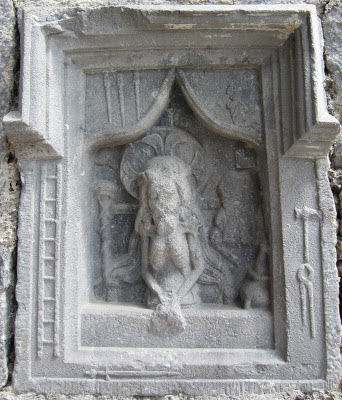His poem entitled A Naoidhe Naoimh (O Holy Child) presents the author as a witness to the nativity of Christ. Here the mystery of the eternal Son of God and the Child of Mary are explored in this excerpt.
Dia do bheatha, a naoidhe naoimh [My greetings to you, o holy child,]
Isan mainséar cé taoi bocht [Though in your manger you are so poor,]
Meadhrach saidhbhir atá tú [In your happiness you are so rich.]
'S glórmhar id dhún féin anocht [You are glorious in your stronghold this night.]
Míle fáilte a–nocht i gclí [My welcomes tonight to the Incarnate]
Le mo chroidhe dom rígh fial [With all my heart to my generous king;]
In dá nádúir ó do-chuaidh [Since he now has two natures,]
Póg is fáilte uaim do Dhia [A kiss of welcome to my God. ]
A naoidhe bhig atá mór [O little child you are so great,]
A leanbáin óig atá sean [O young infant you are so old,]
San mainséar ní chuire a lán [You couldn’t get a lot into that manger]
Cé nach bhfagha áit ar neamh [Yet all of heaven cannot contain you.]
Ar neamh dhíbh gan mháthair riamh [In heaven you never even had a mother]
Gan athair 'nar n-iath a-nos [Nor a father down here below,]
It fhír Dhia riamh atá tú [True God for ever are you]
Is id dhuine ar dtús a-nocht [Yet tonight is your first ever as man.]
His most famous Christmas poem was entitled Don oíche úd i mBeithil (That Night in Bethlehem). It has been put to music and is still a popular Irish Christmas carol (I remember learning it on the tin whistle in school as a child). The incarnation of Christ is described as the safe arrival of the Word (go dtáinigh an Briathar slán). The message and the person of Christ are connected by the title an Briathar (the word).
Don oíche úd i mBeithil, [Of that night in Bethlehem]
beidh tagairt ar ghrian go brách, [There will be mention made forever under the sun]
don oíche úd i mBeithil, [Of that night in Bethlehem]
go dtáinigh an Briathar slán; [When the Word Safely came]
Tá gríosghru' ar spéartha [The skies are glowing]
'san talamh 'na chlúdach bán; [and a blanket of white on the ground]
Féach Íosagán sa chléibhín, [Behold little Jesus in the manger]
'san mhaighdean á dhiúl le grá. [And the Virgin nursing him with love]
Ar leacain lom an tsléibhe [On the bare mountain-side]
go nglacann na haoirí scáth, [Where the shepherds seek shelter]
nuair in oscailt gheal na spéire [When in the bright opening of the skies]
tá teachtaire Dé ar fáil: [God's messenger appears]
Céad glóir' anois don Athair [A hundred glories now to the Father]
i bhflaitheas thuas go hard! [In the highest heaven]
is feasta fós ar talamh [and henceforth now on earth]
d'fheara deamhéin' síocháin! [peace of men and goodwill]











